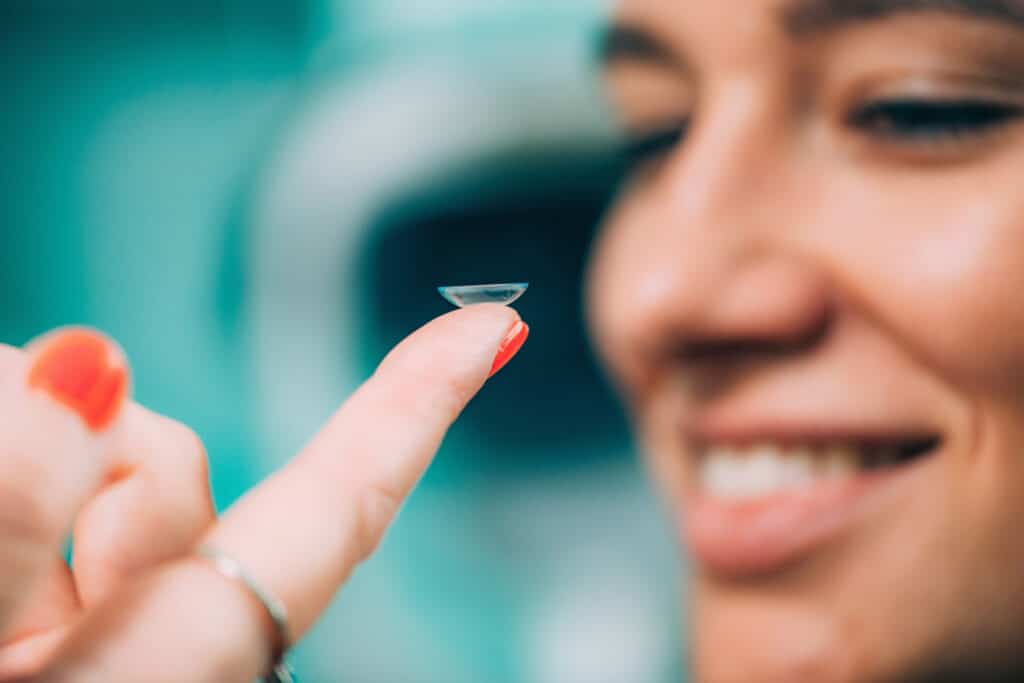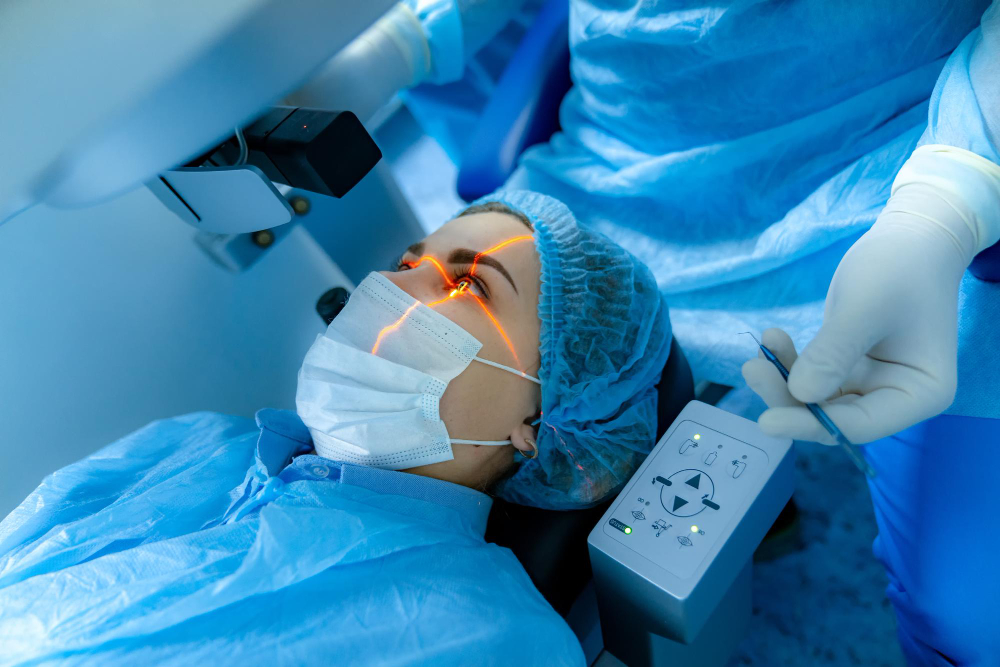A surprising fact: over 140 million people around the world use contact lenses. Many users ask about the maximum time they can keep their contacts in, and the answer might catch you off guard.
Your soft, disposable contact lenses should only stay in for 12 to 16 hours each day. The market offers many options – from daily disposables to monthly ones and even special extended-wear lenses that last up to 30 days of continuous use. Yet 30% to 50% of people who wear contacts still deal with dry eye problems.
Keeping your contacts in too long can harm your eyesight and create risks of eye infections or other serious issues. Eye care experts recommend taking breaks from lenses when you use them 6-7 days weekly and switching to glasses now and then.
The time might be right to look at a lasting solution. Laser eye surgery frees you from daily lens care routines, discomfort, and time limits that come with contacts. Modern technology and personalised treatment from expert doctors make perfect vision without contacts available to more people than ever before. More people now leave their contact lens problems behind, and here’s why.
The Science Behind Contact Lens Wear

The cornea—the transparent front of your eye—faces a unique challenge with contact lenses. Blood vessels are absent in this tissue, so it must get oxygen straight from the air. A contact lens creates a barrier that limits this oxygen supply.
How lenses affect oxygen flow to the eye
Your cornea needs between 3 to 10 µl of oxygen per square centimetre each hour. Low oxygen levels force your cornea to switch to anaerobic metabolism. This process builds up lactic acid and creates an osmotic imbalance. Water flows into the cornea faster than it leaves, which leads to corneal swelling or oedema. Your body might try to fix this oxygen shortage by growing new blood vessels into the clear cornea. This condition, called neovascularization, can damage your vision permanently.
Why lens material and thickness matter
The oxygen that reaches your cornea depends on your lens material and thickness. Traditional hydrogel lenses use their water content to transport oxygen, with typical Dk values ranging from 25 to 50. Modern silicone hydrogel lenses are a big deal as it means that they deliver Dk values above 100. This allows more oxygen to reach your cornea. Lens thickness is a vital factor. To cite an instance, see how thicker lenses needed for stronger prescriptions can reduce oxygen flow dramatically. Your specific prescription strength helps determine how long you can safely wear contact lenses.
Understanding Dk values and eye health
Dk/t measures oxygen transmissibility by combining material permeability (Dk) and lens thickness (t). Experts say daily wear needs a minimum Dk/t value of 30 to prevent corneal hypoxia. Overnight wear requires at least 87, though some researchers suggest 125 is safer. Wearing lenses that don’t let enough oxygen through can cause serious problems. These include corneal swelling, redness, higher infection risk, and possible vision damage. Many eye care professionals now suggest thinking about permanent options like laser eye surgery instead of long-term contact lens use. This is especially true if you experience frequent discomfort or lifestyle limitations.
How Long Should You Really Wear Contact Lenses?
The right wear time for your contact lenses plays a significant role in eye health and helps prevent complications. Research shows all but one of these contact lens wearers follow their eye doctor’s instructions.

How Long Should You Really Wear Contact Lenses?
The right wear time for your contact lenses plays a significant role in eye health and helps prevent complications. Research shows all but one of these contact lens wearers follow their eye doctor’s instructions.
Recommended wear times by lens type
Daily disposable lenses work best when worn 8-16 hours per day. Most users feel comfortable with 10-12 hours of daily wear. New contact lens users should start with four hours on day one and add an hour each following day. Monthly or bi-weekly lenses need removal before bed and proper cleaning each night. These lenses also follow the 8-16 hour daily wear guideline. Extended wear lenses give you more flexibility. Some lenses let you wear them continuously for six nights and seven days, while others work safely for up to 30 days without removal. Notwithstanding that, your optician might suggest a schedule that matches your eye’s tolerance.
Why overuse guides to long-term damage
Contact lens overwear syndrome happens because lenses block oxygen from reaching your eyes through tears. Then, your cornea doesn’t get enough oxygen, which can cause serious problems.
Long-term damage from overwearing contacts includes:
- Corneal hypoxia (oxygen deprivation) that causes abnormal blood vessel growth
- Corneal ulcers or infections that create open sores on your cornea’s outer layer
- Lower corneal sensitivity that lets foreign objects go unnoticed
- Permanent vision damage or blindness in severe cases
The Association for Research in Vision and Ophthalmology’s studies found that extended wear creates “significant changes in all layers of the cornea” that can be “long-lasting”.
How to know when your eyes need a break
Take your lenses out right away if your eyes become red, irritated, dry, itchy, or tear up too much. These signs tell you your eyes need rest. Eye experts suggest regular breaks even if you follow all guidelines. Wearing glasses one or two days each week helps. This strategy lets your corneas get enough oxygen before issues start. A two-week break from contact lenses usually helps reset your delicate corneas. You might want to ask your eye care professional about laser eye surgery as a lasting solution to your vision needs.
When Contact Lenses Become a Burden
Contact lenses offer visual freedom, but they can turn from a solution into a burden over time. Research shows 6% of contact lens wearers face complications each year, and some problems could put your eyesight at risk.
Recurring infections or discomfort
Your risk of keratitis (cornea inflammation) goes up when you wear contact lenses. Studies show 2-5 cases of microbial keratitis occur per 10,000 wearers each year. The risk climbs to 20 per 10,000 for people who wear extended-wear lenses. You should remove your lenses right away if you notice:
- Eye redness and pain
- Vision that becomes blurry
- Sensitivity to light
- Too much tearing or discharge
Lifestyle limitations and daily maintenance
Contact lenses create more than just health risks – they restrict your daily life. Swimming, showering, or taking a bath becomes unsafe while wearing lenses. The tedious cleaning routine takes up valuable time, and poor maintenance stands out as the leading cause of eye infections. The British Contact Lens Association reports that almost 6 in 10 wearers don’t follow proper care guidelines.
The emotional toll of constant eye care
Mental factors play a surprising role in contact lens misuse, with 15.4% of users acknowledging this effect. Research also shows that 16.2% of users notice extended wear as a sign of personal insecurity.
The daily contact lens routine can become exhausting. Think over laser eye surgery as your next step. Book your consultation with Precision Vision London today and start your journey toward clearer, lens-free vision.
Laser Eye Surgery: A Long-Term Solution
Break free from contact lenses with laser eye surgery—a permanent solution for better vision. The procedure lets you say goodbye to daily lens care and replacements.

Benefits over monthly contact lenses vs daily
Laser eye surgery will save you money in the long run. The upfront cost ranges between £2100 and £4,500 for both eyes. This one-time payment eliminates contact lens expenses that add up to £4,800-£6,000 over 10 years. The results speak for themselves—98% of patients get 20/20 vision or better after LASIK. The visual clarity surpasses what contacts can offer.
Why more people are choosing LASIK in the UK
The UK sees over 100,000 laser eye procedures each year. Better safety standards and quick recovery times drive this growing trend. Most patients see better within 24 hours. LASIK actually carries a lower infection risk than long-term contact lens use.
Precision Vision London’s trusted reputation
Dr Pillai, a world-renowned corneal specialist, leads Precision Vision London’s advanced treatment programmes. Their independent, surgeon-led approach gives patients personalised care throughout their trip.
Tailored treatment plans and aftercare support
Advanced wavefront technology helps create custom treatments based on your eye’s unique features. This approach helps patients who other clinics turned away. Every procedure comes with a complete 12-month aftercare package.
Ready to ditch your daily contact lens routine? Think over laser eye surgery. Book your consultation with Precision Vision London today and move toward clearer, lens-free vision. Book Now
Conclusion
Contact lenses can fix your vision temporarily, but they come with more and more limitations over time. Most lenses work for just 8-16 hours each day. The risks of infections, dry eyes, and reduced oxygen to your cornea raise real health concerns. On top of that, daily cleaning routines, lifestyle limits, and regular costs add up to a heavy burden.
Laser eye surgery stands out as a great choice if you’re tired of asking “how long can you wear contact lenses?” The one-time cost saves you money compared to the £4,800-£6,000 spent on contacts over ten years. The amazing 98% success rate in getting 20/20 vision or better shows why more than 100,000 people in the UK choose this procedure every year.
Dr Pillai’s expertise at Precision Vision London will give you treatment that matches your eye’s unique features. The clinic stands out with its advanced wavefront technology, complete 12-month aftercare, and personal attention from the surgeon.
You can break free from the endless loop of wearing, replacing, and maintaining contact lenses. Think about the freedom laser eye surgery brings. Your trip to clearer vision without lenses starts with one consultation. You could join thousands of happy patients who don’t worry about contact lens times or problems anymore. Just imagine waking up each morning to crystal-clear vision without reaching for glasses or contacts.
Key Takeaways
If you’re constantly wondering about contact lens wear times and dealing with daily maintenance hassles, these insights reveal why laser eye surgery might be your best long-term solution:
- Contact lenses should only be worn 8-16 hours daily, with 30-50% of users experiencing dry eye symptoms and increased infection risks from oxygen deprivation to the cornea.
- Extended contact lens use costs £4,800-£6,000 over 10 years, whilst laser eye surgery’s one-time £3,000-£4,000 investment delivers 98% success rates for 20/20 vision.
- Over 100,000 UK residents annually choose laser eye surgery to escape contact lens limitations, lifestyle restrictions, and the emotional toll of constant eye care routines.
- Modern laser eye surgery offers rapid 24-hour vision improvement with lower infection risks than long-term contact lens wear, making it a safer permanent solution.
The science is clear: whilst contact lenses provide temporary vision correction, they create ongoing health risks and financial burdens. Laser eye surgery eliminates these concerns entirely, offering freedom from daily lens maintenance and superior visual outcomes that last a lifetime.
FAQs
Q1. How long before laser eye surgery should I stop wearing contact lenses? For soft contact lenses, you should stop wearing them at least seven days before surgery. If you use hard or gas permeable lenses, it’s recommended to discontinue use for about four weeks prior to the procedure.
Q2. Is laser eye surgery possible for those with high prescriptions? Laser eye surgery can typically correct nearsightedness up to -12.00 diopters and farsightedness up to +6.00 diopters. For astigmatism, corrections can reach up to 6.00 diopters. However, individual suitability depends on various factors, so a consultation is necessary.
Q3. What are the main advantages of laser eye surgery over contact lenses? Laser eye surgery offers long-term vision correction without daily maintenance, reduces the risk of eye infections associated with contact lens use, and can provide significant cost savings over time. It also eliminates lifestyle limitations such as swimming restrictions.
Q4. How soon after laser eye surgery can I expect to see improvements? Most patients notice improved vision within 24 hours after the procedure. Up to 98% of patients achieve 20/20 vision or better following LASIK surgery, offering superior visual clarity compared to contacts.
Q5. Are there any conditions that might make someone unsuitable for laser eye surgery? Certain pre-existing eye conditions such as keratitis, glaucoma, or keratoconus may make a person unsuitable for laser eye surgery. Additionally, if your cornea is too thin, alternative procedures like EVO ICL might be recommended instead.
Authors & Reviewer
-
 Olivia: Author
Olivia: AuthorHi, I'm Olivia, a passionate writer specialising in eye care, vision health, and the latest advancements in optometry. I strive to craft informative and engaging articles that help readers make informed decisions about their eye health. With a keen eye for detail and a commitment to delivering accurate, research-backed content, I aim to educate and inspire through every piece I write.
-
 Dr. CT Pillai: Reviewer
Dr. CT Pillai: ReviewerDr. CT Pillai is a globally recognised ophthalmologist with over 30 years of experience, specialising in refractive surgery and general ophthalmology. Renowned for performing over 50,000 successful laser procedures.

